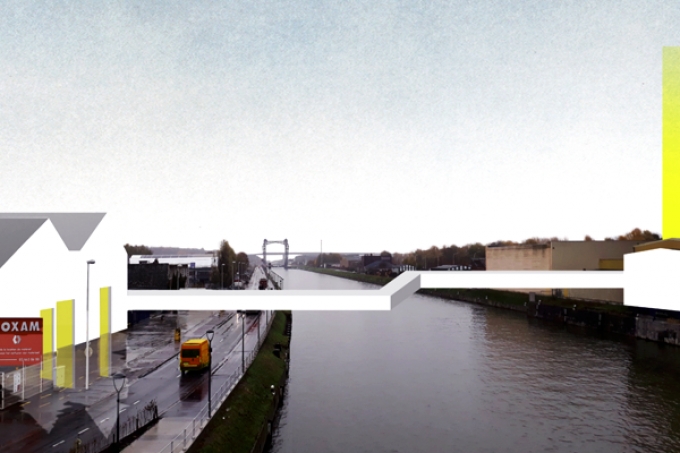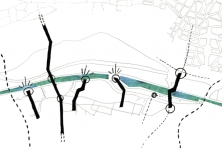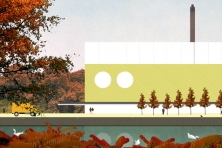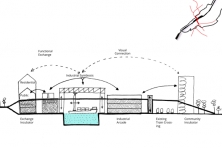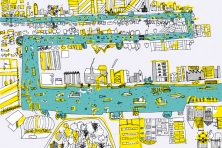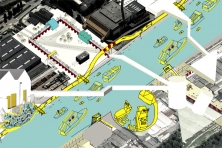ACROSS
Workshop Brussels (BE) - Workshop Site 3
PARTICIPANTS:
Julia Lenoir (FR), Frédéric Blaise (FR), Winner in Grigny&Ris-Orangis (FR) with "Weaving Energies"
Virginia De Jorge Huertas (ES), Winner in La Bazana (ES) with "Bazana Go!"
Tobias Herr (DE), Paul Raphael Schägner (DE), Runner-up in Hamburg (DE) with "DA/ -RIN -RUM -RUNTER -ZWISCHEN"
Lorenzo Ciccu (IT), Carlo Pisano (IT), Runner-up in Linz (AT) with "Rock the Block!"
Sofie Vaasen (BE), Runner-up in Neu-Ulm (DE) with "From Vorefeld to Core-feld"
Simone Valerio (IT), Frederik Vandyck (BE), Runner-up in Tubize (BE) with "Learning From Tubize"
Maria Nuñez (ES,) Runner-up in Warszawa (PL) with "Warszawa Common Places"
Blaž Babnik Romaniuk (SI), Katja Saie (SI), Moica Mlinar (SI) Runner-up in Wien (AT) with "Potent-IAL"
Coach: Luis Basabe (ES)
Guest critics: Ben Dirickx and Tania Vandenbroucke from Brussels Bouwmeester Chief Architect
SITE 3 – NEDER-OVER-HEEMBEEK - SCHAERBEEK FORMATION - BUDA
PORT CITY
This area is located, near the territorial limit of the Flemish and Walloon region, in the Northern part of Brussels. It includes both sides of the canal: Neder-Over-Heembeek and Schaerbeek Formation.
Several issues are raised here, depending on the scales:
1- Schaerbeek Formation is facing huge mutations after the transfer of the station to another site. One part will be redesigned for economic activities, metropolitan equipment is to be developed creating a new neighbourhood open to the canal. The issues are also to optimize the productive factors to organize different types of transports for industries. It would also be the opportunity to enlarge the harbour to develop economic opportunities.
2- Neder-Over-Heembek, on the left side of the canal, has a highly impacted topography and lacks connections to the canal. The challenge is to imagine a landscape connection reaching the canal and the BRYC.
3- On the right side, the Senne River, mostly covered in Brussels, is running in open air. The issue is to think the river as an ecological area increasing life quality of neighbouring industries.
4- Brussels Royal Yacht Club is both a marina and a navigation school on the Northern part. The issue is to develop BRYC as a metropolitan space benefiting from different types of transports and to connect it to Neder-Over-Heembeek. The harbour nearby has to be considered to question its accessibility for both productive and residential activities.
5- On both sides, there are historical industries of the old brewery Marly and the flour production site of CERES. In the long terms, what could new uses and programs could be made of these sites, while keeping their historical features?
6- On the Northern side of the canal, SOLVAY area is being remodeled, buildings are being emptied to reprogram and upcycle some of them with direct links to the canal.
Looked at from above, the Port City Area appears as a huge multifunctional organ, inserted in the very core of Brussels.
Beside its heterogeneous productive content –logistics, industry, transportation, large commercial surfaces-, the area manages to establish a complex relationship with the rest of the city, and especially with the adjacent urban tissues.
Some of these relations have been thematized during the workshop, allowing three corresponding holistic approaches to the channel and its attached infrastructural and productive environment: The canal understood as a vein (ALONG), as a barrier (ACROSS) and as a front (TOWARDS).
ACROSS - Knit-it
Download the PDF here
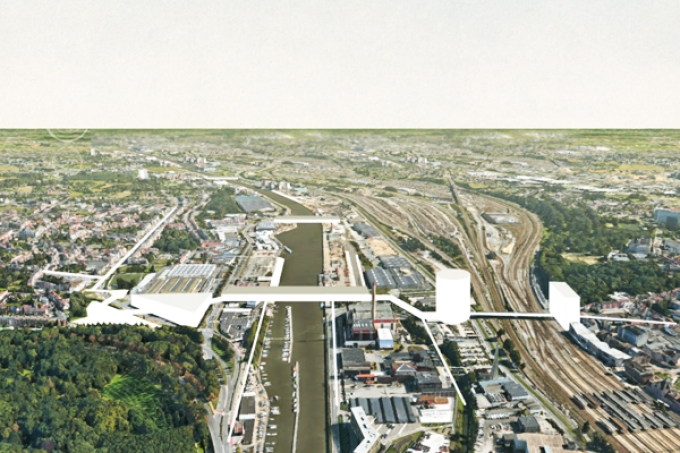
Not only people cross the canal. Also birds do, as well as noise, capital, electromagnetic waves or just sight or odours.
This is the core idea of KNIT-IT, a set of tools able to formulate complex relationships between both sides of the port city, and to translate them into spatial structures. Three relationship scenarios have been developed to connect both sides of the canal: “living bridges”, which generate inhabited paths across the canal; “circular economy cycles”, which thematize production and capital exchange between both sides; and “merging productive ecosystems”, in which ecological diversity and continuity, as well as agricultural production are the linking elements.
Download the PDF here
See other projects on the same site:
See the other sites:
